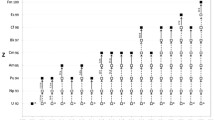Abstract
The concentrations of 237Np, 239Pu and 240Pu were determined in lichen samples (Usnea arizonica) that were collected from ten locations in New Mexico between 2011 and 2013 using isotope dilution inductively-coupled plasma mass spectrometry (ID-ICP-MS). The observed isotopic ratios for 237Np/239Pu and 240Pu/239Pu indicate trace contamination from global and regional fallout (e.g. Trinity test and atmospheric testing at the Nevada Test Site). The fact that actinide contamination is detected in recent lichen collections suggests continuous re-suspension of fallout radionuclides even 50 years after ratification of the Limited Test Ban Treaty.


Similar content being viewed by others
References
Nash TH III (2008) Nutrients, elemental accumulation, and mineral cycling. In: Nash TH III (ed) Lichen biology, 2nd edn. Cambridge University Press, New York, p 234
Richardson DHS, Nieboer E (1981) Lichens and pollution monitoring. Endeavour 5:127–133
Conti ME, Cecchetti G (2001) Biological monitoring: lichens as bioindicators of air pollution assessment—a review. Environ Pollut 114:471–492
Zschau T, Getty S, Gries C, Ameron Y, Zambrano A, Nash TH III (2003) Historical and current atmospheric deposition to the epilithic lichen Xanthoparmelia in Maricopa County, Arizona. Environ Pollut 125:21–30
Thomas RS, Ibrahim SA (1995) Plutonium concentrations in lichens of Rocky Flats environs. Health Phys 68(3):311–319
Purvis W (2000) Lichens. Smithsonian Institution Press, Washington
Brodo IM, Sharnoff SD, Sharnoff S (2001) Lichens of North America. Yale University Press, New Haven
Thakur P, Ballard S, Hardy R (2014) Radiation release at the nation’’ only operating deep geological repository—an independent monitoring perspective. Environ Sci Technol 48(21):12698–12705. doi:10.1021/es503649y
Vanhaecke F, Wannemacker G, Moens L, Dams R, Latkoczy C, Prohaska T, Stingeder G (1998) Dependence of detector dead time on analyte mass number in inductively coupled plasma mass spectrometry. J Anal At Spectrom 13:567–571
Matteson BS, Hanson SK, Miller JL, Oldham WJ Jr (2015) Concurrent determination of Np and Pu isotopes using ICP-MS: analysis of NIST environmental matrix standard reference materials 4357, 1646a, and 2702. J Environ Radioact 142C:62–67. doi:10.1016/j.jenvrad.2015.01.007
Beck HL, Bennett B (2002) Historical overview of atmospheric nuclear weapons testing and estimates of fallout in the continental United States. Health Phys 82(5):591–608
Simon SL, Bouville A, Beck HL (2004) The geographic distribution of radionuclide deposition across the continental US from atmospheric nuclear testing. J Environ Radioact 74(1–3):91–105. doi:10.1016/j.jenvrad.2004.01.023
Widner TE, Flack SM (2010) Characterization of the world’’ first nuclear explosion, the Trinity test, as a source of public radiation exposure. Health Phys 98(3):480–497. doi:10.1097/HP.0b013e3181c18168
Lindahl P, Roos P, Eriksson M, Holm E (2004) Distribution of Np and Pu in Swedish lichen samples (Cladonia stellaris) contaminated by atmospheric fallout. J Environ Radioact 73:73–85
Zheng J, Tagami K, Watanabe Y, Uchida S, Aono T, Ishii N, Yoshida S, Kubota Y, Fuma S, Ihara S (2012) Isotopic evidence of plutonium release into the environment from the Fukushima DNPP accident. Sci Rep 2:304. doi:10.1038/srep00304
Schneider S, Walther C, Bister S, Schauer V, Christl M, Synal HA, Shozugawa K, Steinhauser G (2013) Plutonium release from Fukushima Daiichi fosters the need for more detailed investigations. Sci Rep 3:2988. doi:10.1038/srep02988
Purtyman WD, Peters RJ, Maes MN (1990) Plutonium deposition and distribution from worldwide fallout in northern New Mexico and southern Colorado, Los Alamos National Laboratory, LA-11794
Kelley JM, Bond LA, Beasley TM (1999) Global distribution of Pu isotopes and Np-237. Sci Total Environ 237(238):483–500
Hicks HG, Barr DW (1984) Nevada test site fallout atom ratios: 240Pu/239Pu and 241Pu/239Pu, Lewrence Livermore National Laboratory, UCRL-53499/1
Miller RL (1986) Under the cloud: the decades of nuclear testing. The Free Press, A division of Macmillan Inc, New York
Hanson SK, Miller JL, Oldham WJ Jr (2014) Unpublished data
Widner TE (2010) Final report of the Los Alamos historical document retrieval and assessment project, Centers for Disease Control and Prevention, LAHDRA
Thompson RC (1982) Neptunium—the neglected actinide: a review of the biological and environmental literature. Radiat Res 90:1–32
Bunzl K, Kofuji H, Schimmack W, Tsumura A, Ueno K, Yamamoto M (1995) Residence times of global weapons testing fallout 237Nps in a grassland soil compared to 239+240Pu, 241Am, and 137Cs. Health Phys 68(1):89–93
Hancock GJ, Tims SG, Fifield LK, Webster IT (2014) The release and persistence of radioactive anthropogenic nuclides. Stratigr Basis Anthr Geol Soc, Lond, Spec Publ 395:265–281
Acknowledgments
This work was performed under the auspices of the U.S. Department of Energy by Los Alamos National Laboratory under contract DE-AC52-06NA25396. We thank the Laboratory Directed Research and Development Program for financial support (Project No: 20120459ER). KBL is grateful to the Department of Homeland Security for financial support as a Nuclear Forensics Graduate Fellow.
Author information
Authors and Affiliations
Corresponding author
Rights and permissions
About this article
Cite this article
Oldham, W.J., Hanson, S.K., Lavelle, K.B. et al. Distribution of neptunium and plutonium in New Mexico lichen samples (Usnea arizonica) contaminated by atmospheric fallout. J Radioanal Nucl Chem 307, 2079–2084 (2016). https://doi.org/10.1007/s10967-015-4402-0
Received:
Published:
Issue Date:
DOI: https://doi.org/10.1007/s10967-015-4402-0




